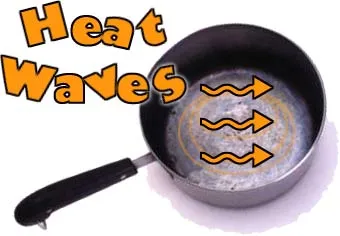 The Teacher's Corner
The Teacher's Corner
Puzzles and Activities
This week's experiment came from making iced tea. I was putting the water on to boil (Yes, I know that makes some of you cringe, but to make true, Southern Sweet Tea, you have to boil the water), and I got caught up in watching the water as it heated.
 To try this, you will need:
To try this, you will need:
Place the pot of water on the burner and turn on the heat. Be sure that the water is well lit, because what we are watching for is the way the light goes through the water. As the bottom of the pot begins to get hot, you should see swirls in the water, just above the bottom of the pot. As things get warmer, the swirls will change, first getting stronger, and then going away.
Why is this happening? It has to do with the speed of light, which is about 186,000 miles per second. (To be exact, 299,792,458 meters per second in a vacuum.) Notice that the last figure states "in a vacuum." That is because when light passes through "things" such as air, glass, or water, it slows down. This slowing can cause the light to bend, which is called refraction. You can easily see this bending by putting a spoon into a glass of water and looking at it from the side. The water bends the light, making it look as if the spoon is broken at the water level.
Just as light travels at different speeds through different materials, it also changes its speed through the same material at different temperatures. You might have seen a good example of this when driving on a hot day. The hot road heats the air just above it. That difference in temperature changes the speed of the light traveling through it, bending the light. This produces a mirage, bending the light to make it look like there is water on the road ahead.
The same thing is happening in our pot of water. The layer of water just above the bottom of the pot is heated, changing the speed that light travels through it. That bends the light, producing the swirl patterns that you see. As the rest of the water gets hot, this difference goes away, and so do the swirls.
Have a wonder filled week.
 Check out more Science Experiments
Check out more Science Experiments
All lessons are brought to you by The Teacher's Corner and Robert Krampf's Science Education Company.
Robert Krampf's Science Shows thehappyscientist.com